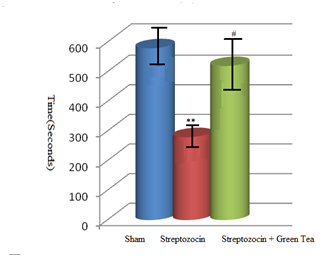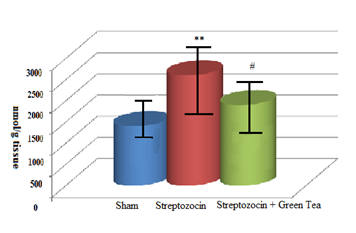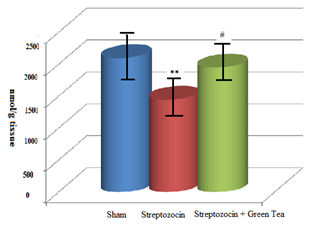MOJ
eISSN: 2379-6294


Research Article Volume 5 Issue 1
1Pharmaceutical Sciences Research center, Mazandaran University of Medical Sciences, Iran
2Department of Physiology and Pharmacology, Mazandarn University of Medical Sciences, Iran
3Pharmacology department-Babol University of Medical Sciences, Iran
4Thalassemia Research Center, Mazandaran University of Medical Sciences, Iran
Correspondence: Ramin Ataee-Assistant Prof-Pharmaceutical Sciences Research center-Mazandaran University of Medical Sciences Payambar Azam buildings-Km 18 Khazar Abad roadSari Iran
Received: December 31, 2018 | Published: January 15, 2019
Citation: 10.15406/mojt.2019.05.00147 DOI: 10.15406/mojt.2019.05.00147
Aims and Scopes: Alzheimer's disease (AD) is the most common kind of progressive neurodegenerative dementia of the aged brain, many promising chemicals have failed because of therapeutic limitations i.e. only making symptomatic relief. Antioxidant system, is known in etiology of AD. This imbalance may originate from an overproduction of free radicals or from a reduction in antioxidant defenses. Green tea has been proven as anti-oxidative herbal agent in prevention of some neurodegenerative disease as parkinson, alzheimer and depression, Antioxidative properties of green tea belong to polyphenol compounds as cathechin and epi gallo- cathechin, according to these background we planned to study preventive role of green tea extract on streptozocin related brain oxidative stress and cognitive impairment.
Materials and methods: Materials and methods for experimental model of Alzheimer, 3mg/kg i.c.v STZ was administered twice to wistar male rats, green tea hydroalcoholic extract administered for 3 weeks by gavage (100 mg/kg/1ml), after than animals have gone for behavioral cognitive studies through passive avoidance test by shutle box apparatus and after killing their brain tissue have been assayed for oxidative stress exams.
Results: Cognitive impairment observed in animals which received streptozocin as increased their latency time and green tea could have decreased their latency time and green tea can prevent this impairment. Also green tea extract could ameliorate oxidative stress parameter as MDA, Glutation, Catalase and SOD significantly
Conclusion: According to results of this experiment we can suggest green tea extract for old people who are at risk of Alzheimer and also may involve diabetes.
Keywords: alzheimer, streptozocin, gree tea, passive avoidance, oxidative stress
Alzheimer's disease (AD) is the most common kind of progressive neurodegenerative dementia of the aged brain, many promising chemicals have failed because of therapeutic limitations i.e. only making symptomatic relief. Antioxidant system, is known in etiology of AD. This imbalance may originate from an overproduction of free radicals or from a reduction in antioxidant defenses.1,2 These disturbances are involved especially in cortex area, hippocampus and median and temporal lopes of the brain.1,2 Also other Alzheimer's signs are decrease in acetylcholine which accompanies with disease deterioration. This disease is also with collapse and neuron degenerations and cognitive and perceptual disturbances.1,2 According to epidemiological aspects, the probability of disease is increased with increasing of age, as during 5 years' period since 65 years old, the rate of disease will increase twice from rate of 1% to 20% in 85 years old.1,2 Alzheimer include 50-70% all brain dementias and in developmental courtiers and its' rate of incidence has been increased from 13.5 million to 36.7 million between years of 2000 and 2005.1,2 It has demonstrated that oxidative stress is as pathological causes of Alzheimer.3–6 Green tea with scientific name of Camellia Sinensis from Theaceae family has been proven as anti-oxidative herbal agent in prevention of some neurodegenerative disease as parkinson, alzheimer and depression, Antioxidative properties of green tea belong to polyphenol compounds as cathechin and epi gallo- cathechin,7–9 One of oxidative stress and loss of memory in mouse brain is streptozocin injection intraventricularly which is one of Alzheimer model.9
Given that studies about relationship between green tea and loss of memory is new, this study has been aimed to assay effects of hydroalcoholic extract of green tea on memorial behavior of rat.
Animals
Wistar Albina male rats weighting 200-250gm have been prepared from laboratory animal breeding and maintenance assembly, Mazandaran University of Medical Sciences, Sari Iran and maintained in optimum humidity and temperature (24-270C and 60-65% humidity). Working with animals was under ethics committee protocols of Mazandaran University of Medical Sciences.
Materials
Green tea leaves have been accumulated from Lahijan farm in spring season, Streptozocin and Thiobarbituric acid (TBA) have been prepared from Sigma Co.USA. Other materials as mannitol, ether, methanol and ethanol from merk Co, germany. GSH, Super oxide dismutase and Catalase kits have been provided from Roach Co, Germany.
Extraction from green tea
200gm green tea leaves have been prepared as hydro-alcoholic extract (%80 ethanol extract) with percolator as suspension and used as liquid.
Intracerebroventicular injection
Streptozocin has been dissolved in normal-saline 0,5% and maintained in 40C. The injection dose was 3mg/kg4 which done intracerebroventicularly twice with 48hr interval as after anesthetizing of animal with ketamine/xylensene and fixation with stereotaxic, after mid brain sagittal cutting of head skin and making hole in jump as mirror and lateral coordinates:9 mm posterior to bregma; 1.5mm lateral to sagittal suture; 3.6 beneath the surface of the brain and after cannulation and fixation with specific cement, streptozocin injection as 5µl has been done, two way by Hamilton syringe (Figure 1).4
Green tea treatment and behavioral study
One week after treatment and STZ injection, green tea extract after dissolving in ethanol (50/50) has been administered orally by gavage as 100mg/kg in volume of 1ml for 21 days.8,9 After that in days 21 and 23 for behavioral study, passive avoidance test with shuttle box has been used.10
Tissue preparation
Rats in day 23 after anesthesia with ether were killed with cold normal saline injection to their hearts and their brains have been removed and hippocampus tissues were removed for morphological study and then homogenized in homogenizer in mannitol serum for oxidative stress studies.10
Biochemical studies
Biochemical oxidative stress parameters as Malonyl dealdeyde (MDA) level for lipid peroxidation, Glutathion(GSH), Catalase and Superoxide dismutase enzymes activities, all have been assayed by calorimetric methods (10) in tissue homogenates of rat brain.
Statistical Analysis
For statistical analysis, SPSS software version 22 and one-way ANOVA with Post Tuckey test has been used.
Passive avoidance test
According passive avoidance test, STZ could have induced decrease in latency time in positive control group (Figure 2) and green tea extract in 100mg/kg dose for 3 weeks could increase latency time significantly (Figure 2).

Figure 2Comparison between groups of STZ, Green tea and Sham for passive avoidance test and their effects on latency times.#:significant compared with sham group P0.05.**:significant compared with STZ group.
Lipid peroxidation test
STZ increased lipid peroxidation and MDA concentration in brain concentration of mice and green tea administration for 21 days decreased significantly (Figure 3).

Figure 3Comparison between groups of STZ, Green tea and Sham for lipid peroxidation and MDA conct..#:significant compared with sham group P0.05.**:significant compared with STZ group.
Glutathione test
According to glutathione test, STZ could have reduced tissue glutathione in rat brain and treatment with green tea extract for 21 days increased it significantly (Figure 4).

Figure 4Comparison between groups of STZ, Green tea and Sham for Glutathione conct..#:significant compared with sham group P0.05.**:significant compared with STZ group.
Catalase and superoxide dismutase test
Streptozocin could have decreased tissue activity of catalase and superoxide dismutase in rat brain and green tea administration for 21 days increased their activity significantly (Figure 5).
According to our previous studies we have shown that curcumin can inhibit lipid-peroxidation induced by homocysteine in rat brain hippocampus and decreased MDA and SOD in rat brain.10 In recent years, green tea has been considered in use in treating of cancer, cardiovascular and inflammatory diseases.9 Green tea contains active material rich in flavonoids including cathechines and epigalocathechines. Cathechines absorbs orally with good availability and stable in stomach and intestine.11 some studies shown that green tea reduced risk of Parkinson disease12 and epigalacto-cathechine in green tea can protect dopaminergic neurons against neurotoxin MPTP.8 Intra cerebro venticular injection of stz under diabetogenic dose can disturb brain metabolism in long term and oxidative stress in brain and cognitive impairment and memory and reduce ATP and Acetylco A and subsequently reduce cholinergic activity in hippocampus which occurs in pathology of Alzheimer.13 I some studies it was revealed that in oxidative stress, levels of serum met-hemoglobin have been increase which can be considered as lab bio-marker for oxidative stress14–16 In our study in passive avoidance test some significant improvement in memory of rat have been observed and reduction in lipid peroxidation, increase in GSH, SOD and catalase all indicated role of green tea as a preventive herbal agent against oxidative stress in animal brain. These results accompanying our previous study about curcumin in Alzheimer model of homocysteine10 and also in parallel with M Levites, Y Sheida.7,8 As in this study we used STZ which is a diabetogenic material and can disturb glucose metabolism in brain and can be a pathological cause of Alzheimer in elderly, we can consider role of green tea as anti-oxidative stress for prevention of Alzheimer, especially in diabetic old people. How away it is necessary to develop in vivo studies to assay more role of green tea in Alzheimer disease with assaying more prognostic and inflammatory parameters in Alzheimer.
According to results of this study we can consider green tea as preventive herbal medication against oxidative stress in brain especially in pathophysiology of Alzheimer especially with diabetes.
This article is as result as proposal of PharmD student, Mohammad Shahidian with financial supports of deputy of research, Mazandaran University of Medical Sciences, Sari Iran, and appreciate all of supports,
There is not any conflict of stress between authors in all parts of article preparations.

©2019 10.15406/mojt.2019.05.00147, et al. This is an open access article distributed under the terms of the, which permits unrestricted use, distribution, and build upon your work non-commercially.